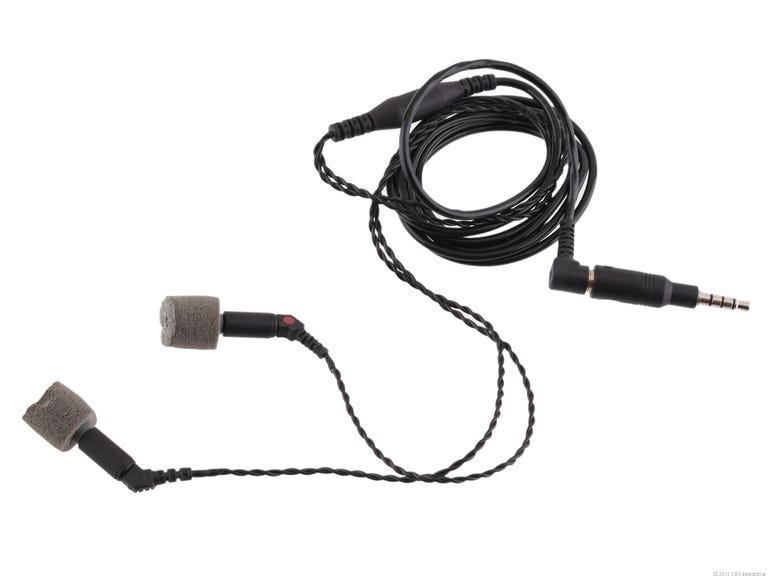 Why You Can Trust CNET
Why You Can Trust CNET Etymotic ER-4PT MicroPro review: Etymotic ER-4PT MicroPro
Etymotic ER-4PT MicroPro
First, a bit of clarification. In case you didn't realize it, Etymotic has four versions of its ER-4 MicroPro series earphones, each of which retail for $299. According to the company, here's how the differences break down:
The Good
The Bad
The Bottom Line
The Etymotic MicroPro ER-4B is "for binaural recording monitoring and used in professional settings."
The Etymotic MicroPro ER-4S is the company's "stereo monitoring earphone and geared to those listening through a powered recording or 'front of house' monitoring board."
The Etymotic MicroPro ER-4P is the most mainstream of the bunch, designed for those using a portable audio device as their primary audio source.
The Etymotic MicroPro ER-4PT, reviewed here, is the latest version of the 4P. Etymotic says it's made for the professional traveler who uses his or her earphones on planes as well as professionally.
To be clear, the ER-4Ps and ER-4PTs are essentially the same products, but they're packaged differently. The ER-4PT has different adaptors for plane use and also comes with a Channel Matching Compliance Graph that states to the owner that his or her ER-4PT has passed all accuracy tests and each channel has been hand matched and certified within 2 dB over a defined audio spectrum.
(If you're still confused, check out Etymotic's Web site for a more detailed explanation on the ER-4 MicroPro model line. As an aside: that's way too many model numbers for four very similar products. We'd suggest Etymotic pare down its number of SKUs to make things as simple as possible for shoppers.)
OK, now on with the review. The first thing you'll notice about these Etymotics is the earphones themselves are somewhat long, slender cylinders that make you feel as if you're almost jamming sticks in your ears, which is not a bad thing in this case. Several Etymotic models are shaped this way, and we only point it out from an aesthetic standpoint that these guys protrude from your ears a little more than some earphones.
They come with a two different "Accu-fit" noise-isolating eartips (foam and silicone rubber) designed to completely seal your ear off from the outside world. You can also get personalized "Custom-fit" eartips, which Etymotic offers for $100 extra.
Overall, the ER-4PT earphones are well-designed, with a thick main headphone cord that splits off into two braid-reinforced cables going to each earphone. (The ER-4PT's have a two-year warranty.) One complaint: The plastic surrounding the right-angle headphone plug is on the thick side and if you have a case on your smartphone or portable audio device (say, an iPod Touch), you may not be able to get the plug all the way into your device's audio jack (this reviewer couldn't plug into his iPhone without removing its case).
It's also worth noting that because you get such a tight seal with these earphones, you really can't hear much of the outside world, which may be dangerous if you're walking around town and need to be aware of some audio cues from what's going on around you. We also noticed that we heard the cord rubbing against our clothing as we walked. So ideally, these earphones are better suited to stationary listening. (Both issues are common among all such in-ear headphones.)
As for the sound quality, we really like it. The ER-4PT has a leaner--and we'd say more accurate--tonal balance than most in-ear headphones in its price class. That is, it lacks the overly ripe bass common to many high-end in-ear headphones. The ER-4PT's treble clarity and precision let you hear exactly what's going on in the recording.
We started our auditions comparing the ER-4PT with the less expensive Etymotic HF5 in-ear headphones while listening to Gregg Allman's new "Low Country Blues" album. The two headphones share a similar sound, but the ER-4PTs' lower bass and midrange have a richer and more satisfying balance. The recording has a lot of bass, and we feel the HF5s are lacking in that regard.
That said, if you really like a lot of bass, the ER-4PTs may come up short. They definitely have less low-end oomph than the Monster Turbine Pro Gold in-ear headphones. While listening to "Green Onions" from Tom Petty and the Heartbreakers' "The Live Anthology" CD set, we thought the drums sound dynamic and powerful and the guitars really cut through over the ER-4PT. The Turbine Pro Gold add weight and punch to the bass, but the drums' attack is softened compared with the ER-4PT. The Turbine Pro Gold is still a good headphone, just not as accurate as the ER-4PT.
The accuracy of the ER-4PT makes it easy to hear the difference in sound quality between two live Bob Marley CDs, the recently released "Live Forever: Live at the Stanley Theatre" and "Live at the Roxy." The Stanley record has a coarse, mildly distorted quality, so the drums' cymbals sound fuzzy. The Roxy songs are more vivid and clear, and you can hear that the audience is really having a great time. The ER-4PT can tell you more about the music than lesser headphones would, and when the music sounds good, you hear it--that's what you should expect from earphones that cost $300.
Freelancer Steve Guttenberg contributed to this review.


